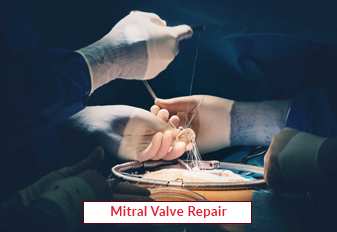Mitral Valve Repair

Mitral valve repair is a surgical procedure performed to restore proper function to the Mitral Valve Replacement Surgery, which is located between the left atrium and left ventricle of the heart. This valve ensures that blood flows in the correct direction, preventing backflow and maintaining efficient circulation. Mitral valve repair aims to treat various mitral valve conditions, such as regurgitation (leakage) or stenosis (narrowing), to improve heart function and prevent complications.
Book an AppointmentAbout Mitral Valve Repair
The mitral valve consists of two leaflets that open and close during each heartbeat to allow blood to flow from the left atrium to the left ventricle and prevent backward flow. When the Mitral Valve Replacement Surgery is affected by conditions such as regurgitation or stenosis, it can lead to symptoms like fatigue, shortness of breath, and decreased exercise tolerance. Mitral valve repair aims to restore the valve's proper function, rather than replacing it with an artificial valve, whenever possible.
Procedure of Mitral Valve Repair
-
Preoperative Evaluation: Before mitral valve repair, a comprehensive evaluation of the patient's heart condition, valve function, and overall health is conducted. This includes imaging tests, such as echocardiography, cardiac catheterization, and sometimes cardiac MRI, to assess the valve structure, function, and any associated abnormalities.
-
Anesthesia and Incision: The procedure is performed under general anaesthesia. A sternotomy (a vertical incision through the breastbone) or a smaller thoracotomy incision may be made to access the heart and the mitral valve.
-
Valve Examination and Repair: The surgeon carefully inspects the mitral valve to assess the extent of damage or dysfunction. The repair techniques used will depend on the specific valve condition but may include:
a. Valve Annuloplasty: The surgeon may reshape or reinforce the valve annulus (the ring-like structure that supports the valve leaflets) using a flexible ring or band. This helps restore the valve's proper shape and improve its closing mechanism.
b. Leaflet Repair: Damaged or weakened valve leaflets may be repaired by removing excess tissue, repairing tears, or reinforcing weakened areas. This restores the leaflets' normal function and ensures effective closure.
c. Chordal Reconstruction: If the supporting chordae tendineae (tendinous cords that connect the valve leaflets to the heart muscle) are damaged or elongated, they may be repaired or replaced to restore proper leaflet alignment and function. -
Testing and Adjustments: After the repair is completed, the surgeon tests the valve's function by filling the heart with saline solution and observing its closure. Any necessary adjustments or additional repairs are made to ensure optimal valve performance.
-
Closing the Incision: Once the mitral valve repair is successful, the incision is closed using sutures or staples. Sterile dressings are applied to promote healing.
-
Postoperative Care and Recovery: The patient is closely monitored in the intensive care unit (ICU) following surgery. Medications to support heart function, prevent infection, and manage pain are administered. Rehabilitation, including physical therapy and gradual resumption of activities, is initiated to aid in recovery.
Require Assistance?
Get A Quick Callback From Our Healthcare Experts
Other Specilities We Cover

Robotic Heart Bypass Surgery

Heart Bypass Surgery




